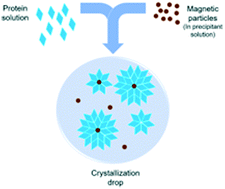Magnetic particles used in a new approach for designed protein crystallization†
Abstract
After more than one hundred and thirty thousand protein structures determined by X-ray crystallography, the challenge of protein crystallization for 3D structure determination remains. In the quest for additives for efficient protein crystallization, inorganic materials emerge as an alternative. Magnetic particles (MPs) are versatile inorganic materials, easy to use, modify and manipulate in a wide range of biological assays. The potential of using functionalised MPs as crystallization chaperones for protein crystallization was shown in this work. MPs with distinct coatings were rationally designed to promote protein crystallization by affinity-triggered heterogeneous nucleation. Hen egg white lysozyme (HEWL) and trypsin, were crystallized in the presence of MPs either bare or coated with a polysaccharide (chitin) or a protein (casein), respectively. The addition of MPs was characterized in terms of bound protein to the MPs, crystal morphology, time-lapse of crystal emergence, crystallization yield fold change and crystal diffraction quality for structure determination. The MPs additives have shown to bind to the respective target protein, and to promote nucleation and crystal growth without compromising crystal morphology. On the other hand, MPs addition led to faster detectable crystal emergence and up to 13 times higher crystallization yield, addressing some the challenges in protein crystallization, the main bottleneck of macromolecular crystallography. Structure determination of the protein crystallized in the presence of MPs revealed that the structural characteristics of the protein remained unchanged, as shown by the superposition with PDB annotated proteins. Moreover, and unlike most reported cases, it was possible to exclude the inhibitor benzamidine during trypsin crystallisation, which is a remarkable result opening new prospects in enzyme engineering and drug design. Our results show that MPs coated with affinity ligands to target proteins can be used as controlled and tailor-made crystallization inducers.

- This article is part of the themed collections: Biomolecular crystal engineering and Crystal Growth


 Please wait while we load your content...
Please wait while we load your content...